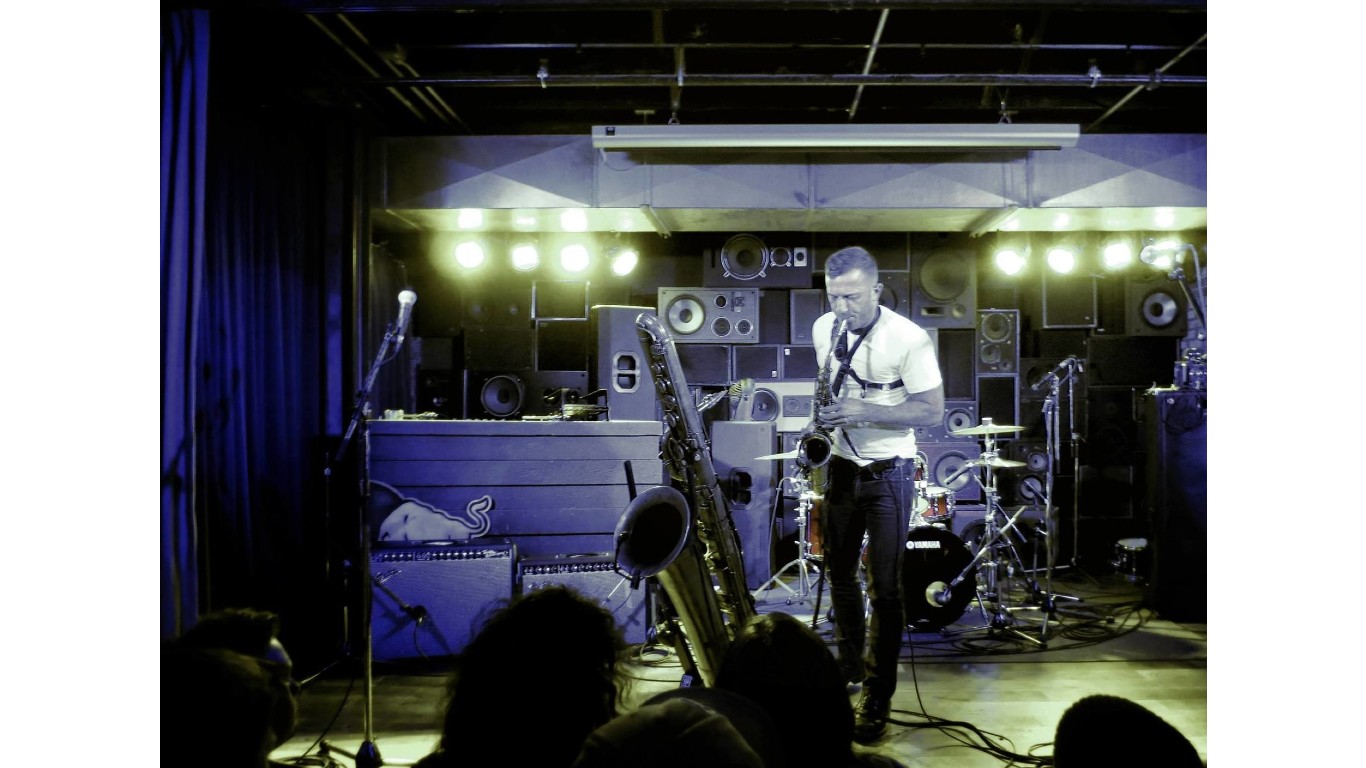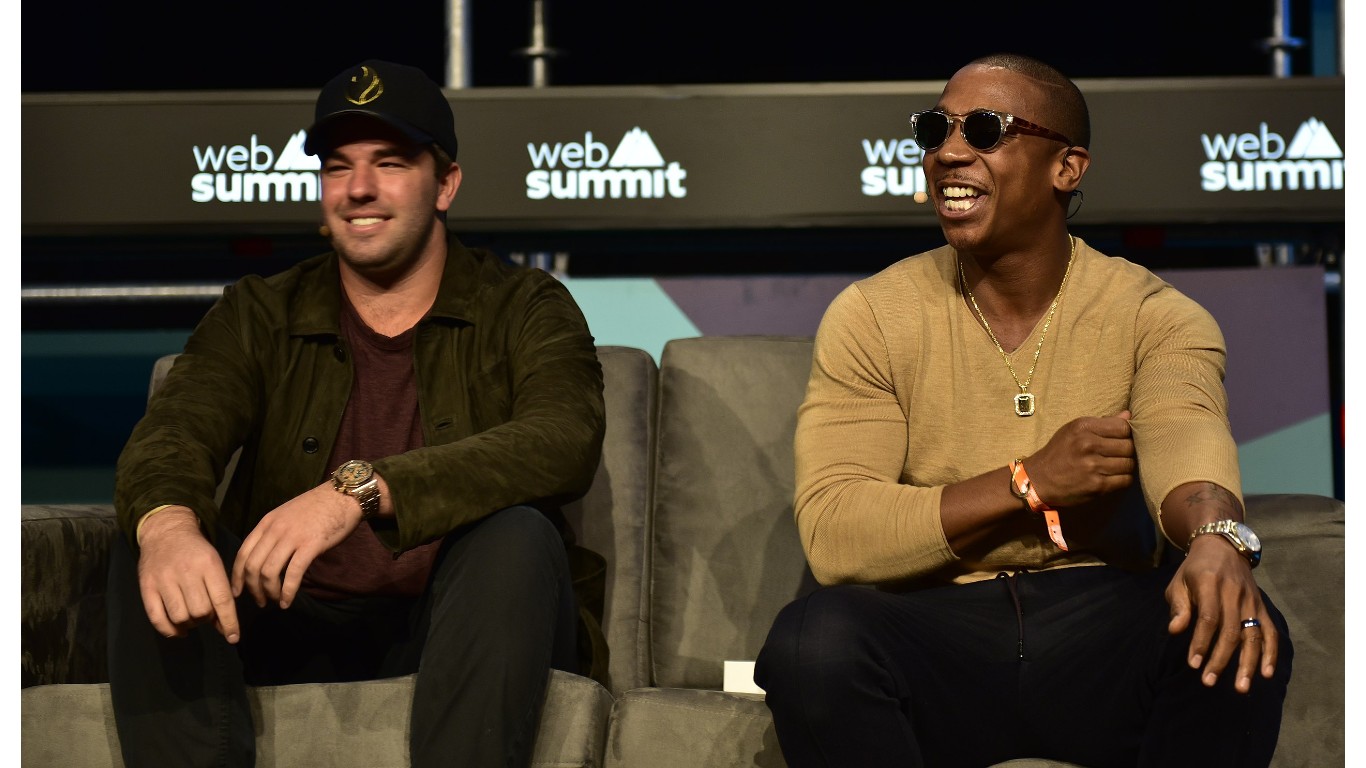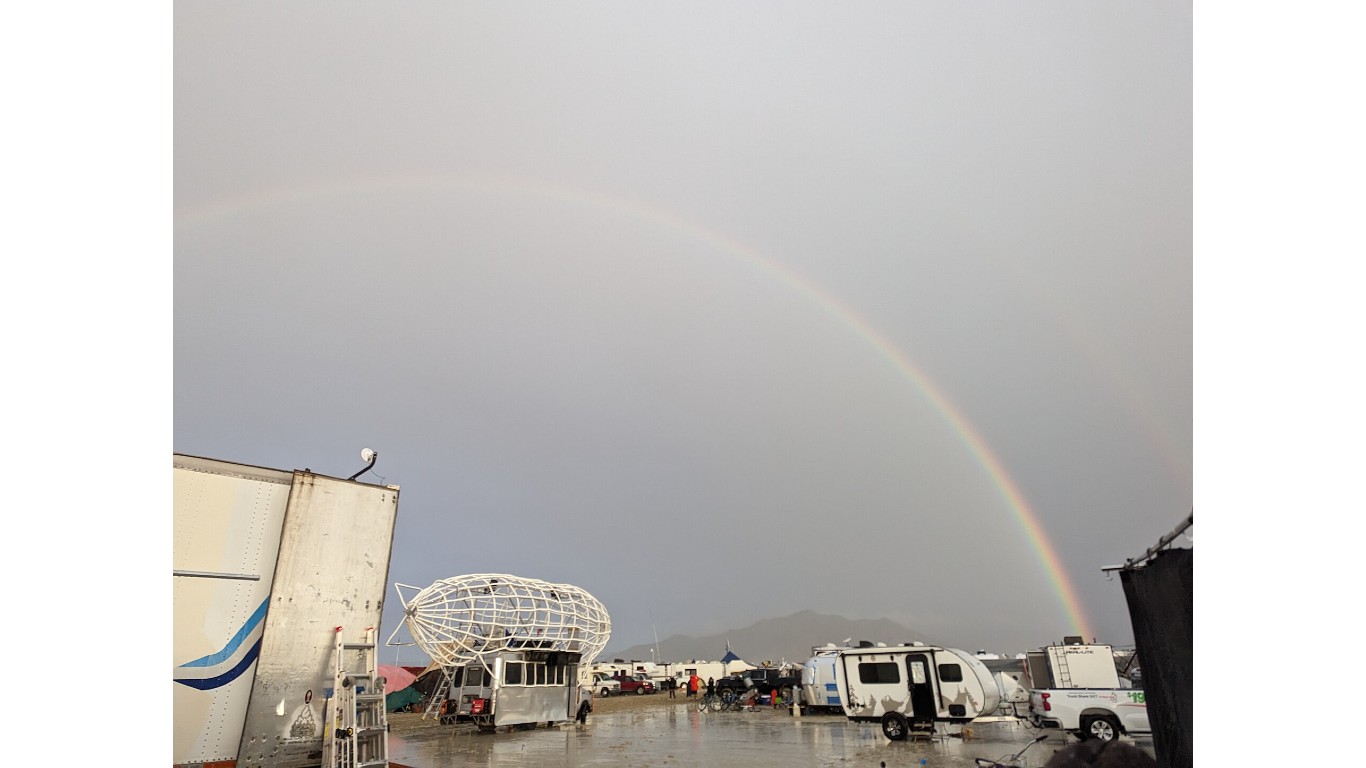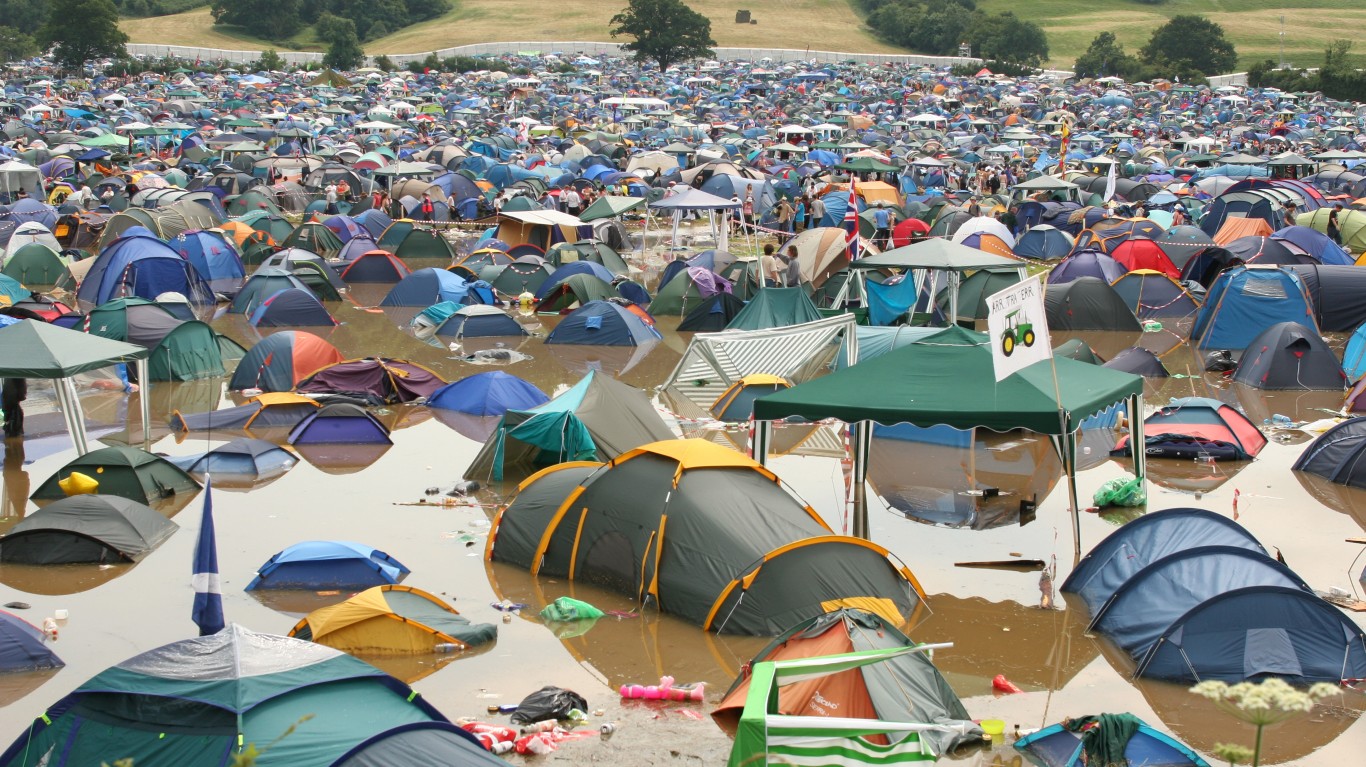
Festivals – often based around music of various genres, but also sometimes focused on dance, film, theater, or other arts – date back to Ancient Greece, with the earliest ones specifically focused on music appearing in England in the 18th century. (The music was more likely to have been concert-level than popular folk music or the like.)
The longest-running such event in modern times is the Festival di Sanremo, a song contest, with prizes, launched in the town of Sanremo, on the Italian Riviera, in 1951. (An offshoot, now more popular, is the Eurovision Song Contest, which was first held in 1956.)
In our own time, rock, country, electronic, hip-hop, and other kinds of music have been given festivals of their own (some blend different kinds on the same program), and are famous for drawing huge crowds.
The quintessential example of such a festival is the legendary Woodstock, held in August, 1969, on a dairy farm in Bethel, New York. Icons of the era, including Jimi Hendrik, Joan Baez, Ravi Shankar, Janis Joplin, The Who, Grateful Dead, and Cosby, Stills, Nash & Young took the stage, and despite intermittent rain, three fatalities (two drug overdoses, one case of a sleeping teenager run over by a tractor), and subsequent lawsuits by local farmers, Woodstock was considered a success and remains a counterculture landmark.
Of course, festivals can go very wrong. Huge crowds stirred up by music, passionate fandom, drug and alcohol use, logistical issues like inadequate facilities or aggressive security…What could go wrong?
Throw in bad weather – oppressive heat, torrential rainfall, flash floods – in what is nearly always an outdoor setting, and it’s frankly surprising that more festivals don’t end in disaster. (These are the 20 states with the worst risk of flooding.)
Click here to read about 18 major festival disasters
To compile a list of 18 festivals that did come to disastrous ends, 24/7 Tempo reviewed a report on the subject published by SuperCasinoSites, an information and review site devoted to casino gaming around the world, as well as news reports in daily news publications.
Some festival disasters are relatively minor: rain and mud cause delays or cancellations. One was an outright con job. Many of those listed here were marred by fatalities – and one holds the grim distinction of having ended in the largest mass shooting by a single perpetrator in U.S. history. (It’s at the top of our list of the deadliest mass shootings since the Columbine massacre.)
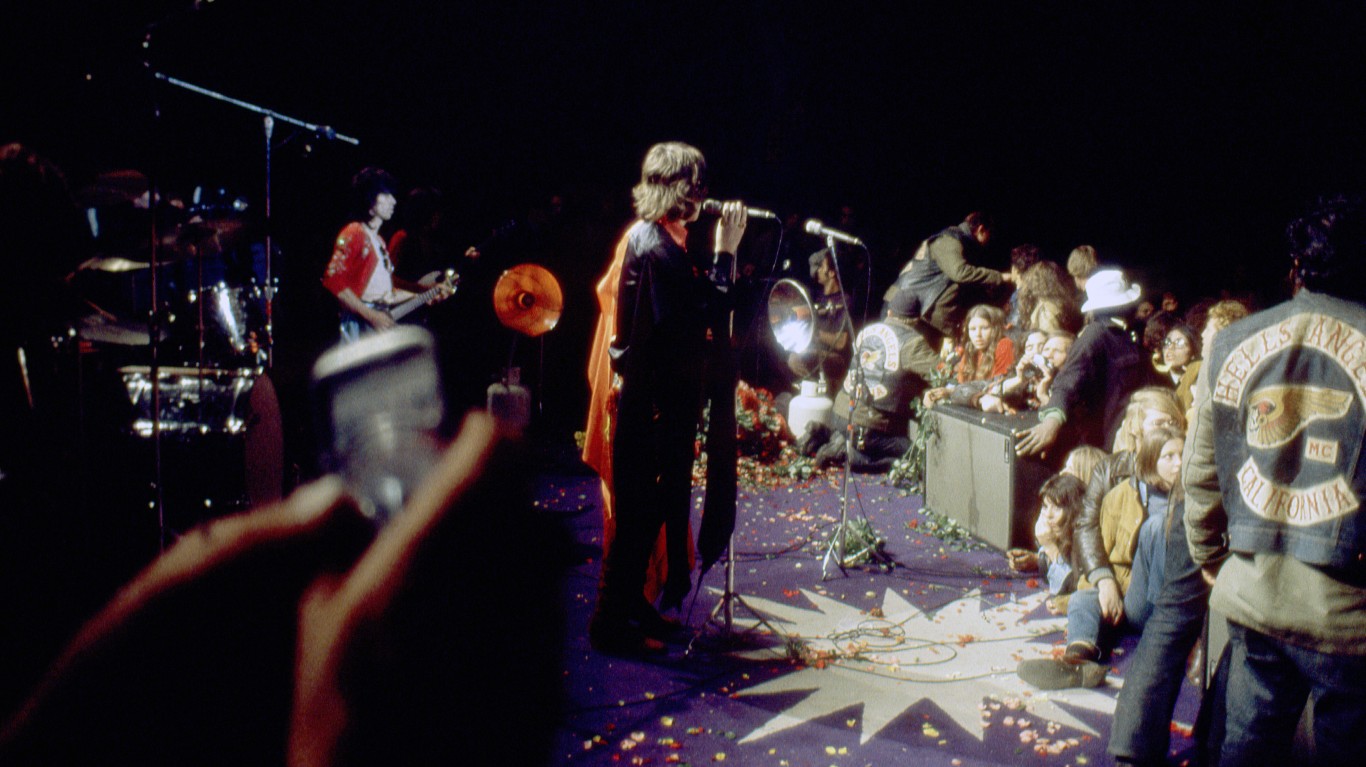
Altamont Speedway Free Music Festival
> Year: 1969
> Location: Altamont Speedway, Tracy, California
> Approximate attendance: 300K
This now-infamous event, organized by Jorma Kaukonen and Spencer Dryden of the Grateful Dead, has been said to mark the death of the era of “peace and love” as symbolized by Woodstock, which preceded it by just four months. Acts appearing included Jefferson Airplane, Santana, and the Rolling Stones, but the Dead declined to go on, sensing the bad vibes on the site. Hard drug use, inadequate facilities, and the use of the Hell’s Angels to provide security added up to tragedy – culminating in the stabbing death of one concertgoer by the Angels after he pulled a gun. In addition, there were three accidental deaths, multiple injuries, and extensive property damage and car theft. The 1970 Maysles brothers documentary “Gimme Shelter” chronicles the event.
[in-text-ad]
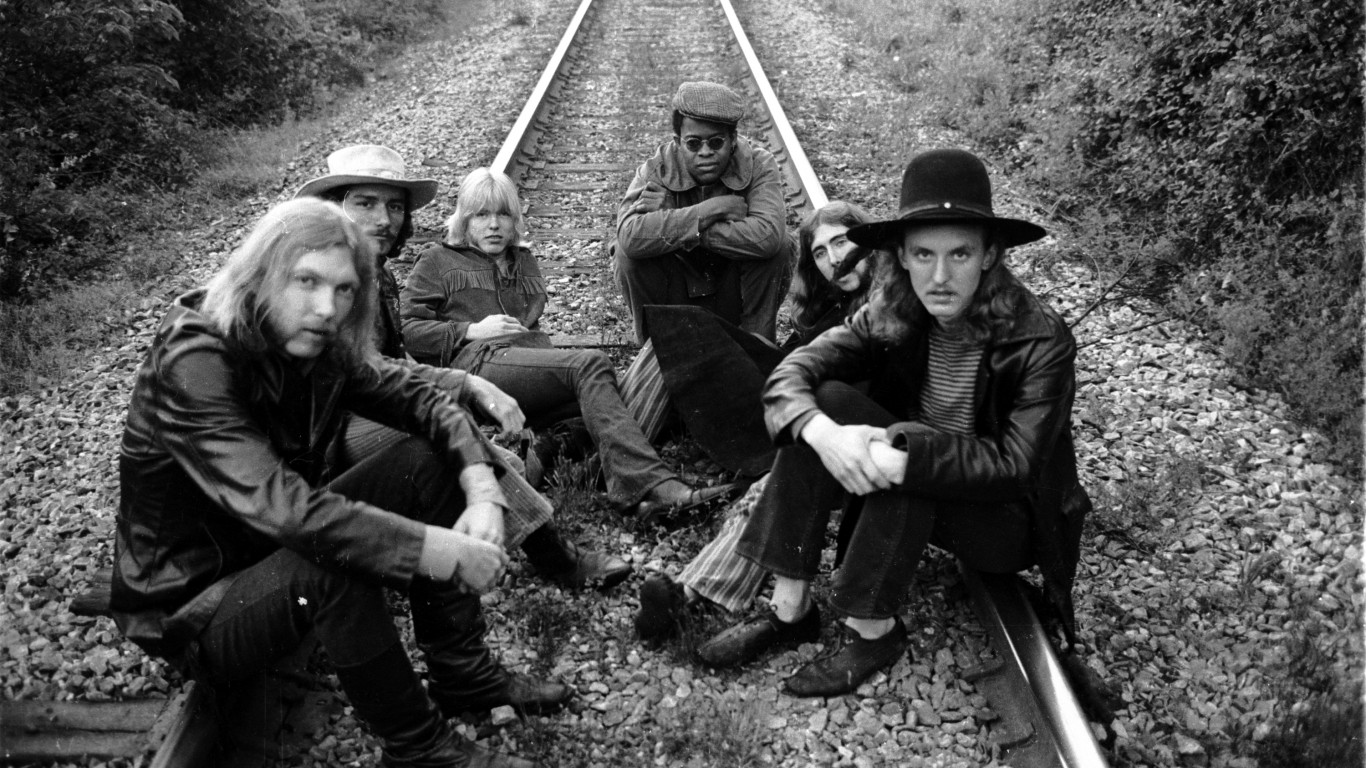
Erie Canal Soda Pop Festival
> Year: 1972
> Location: Bull Island, Illinois/Griffith, Indiana
> Approximate attendance: 200,000K+
The organizers of this festival full of big names on Bull Island, Illinois, next to Griffith, Indiana – Black Sabbath, the Allman Brothers, Fleetwood Mac, Joe Cocker, Santana, and many more – sold 30,000 advance tickets to the event and expected maybe another 25,000 to 30,000 would buy entry at the gates. In fact, a crowd of at least 200,000 showed up expecting to get in (some estimates place the number at 300,000). Drugs were sold openly, but food and drink were in short supply and food vendors were looted and food stands destroyed. Many of the name acts canceled on the spot, and three concert-goers drowned in the Wabash River trying to leave the site. Bull Island, various vendors, the states of Indiana and Illinois, and the IRS all filed suit against the promoters.
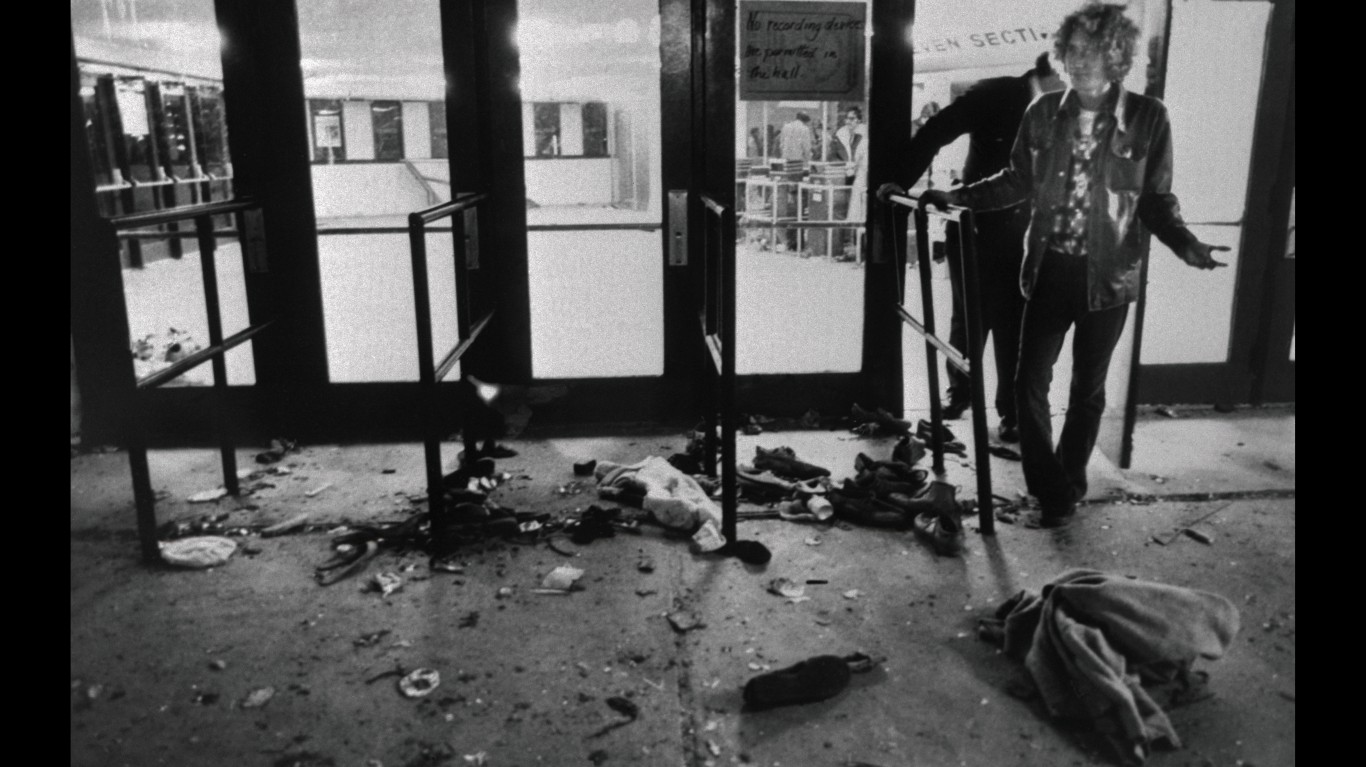
The Who Concert
> Year: 1979
> Location: Riverfront Coliseum, Cincinnati, Ohio
> Approximate attendance: 18K
This appearance by The Who, part of their 1979 world tour, turned to tragedy when ticket-holders, who had been told by a local radio station that the venue entrances would open at 3 p.m., were still standing outside by 7:15 p.m., when they heard either a soundcheck by the band or a pre-concert screening of the group’s movie “Quadrophenia,” and thought the concert had started. They surged through the doors in a panic, resulting in 11 fatalities, as well as 26 non-fatal injuries.
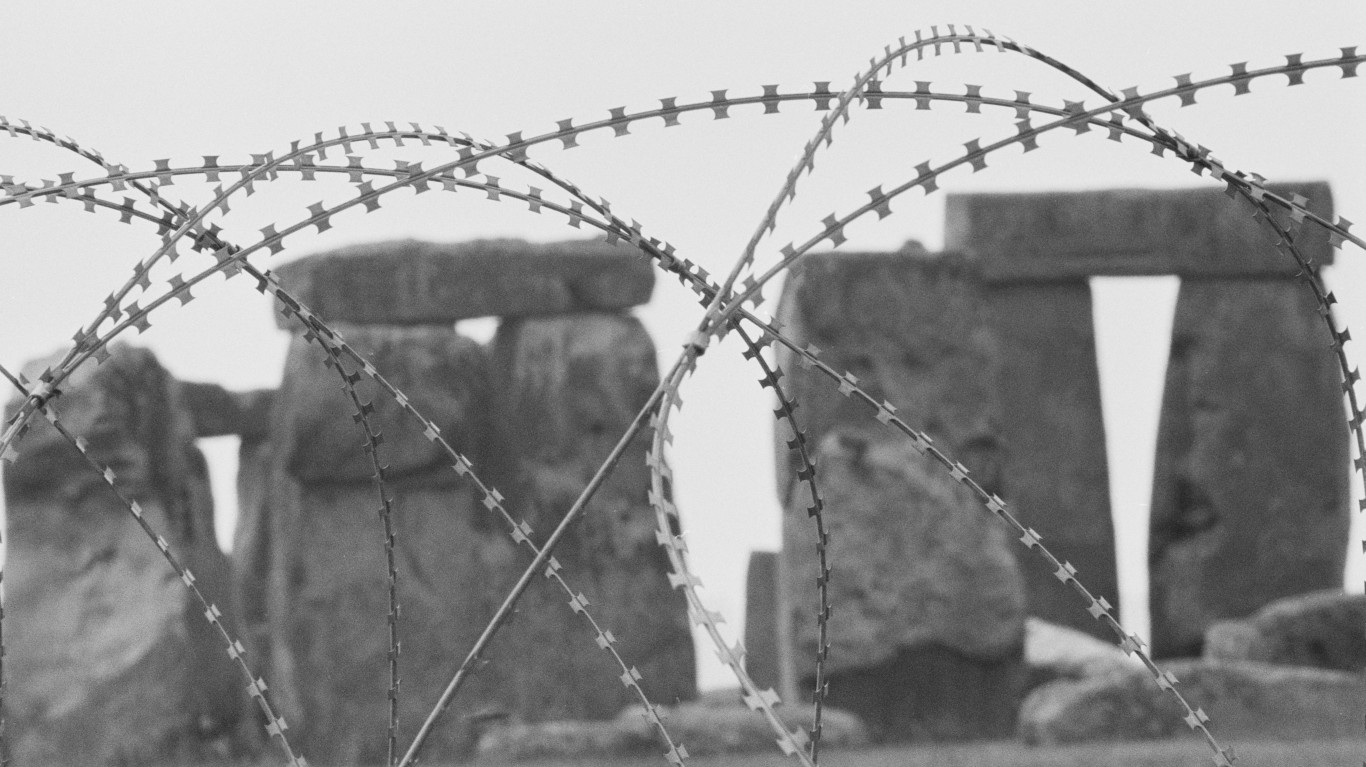
Stonehenge Free Festival
> Year: 1985
> Location: Stonehenge, Salisbury Plain, England
> Approximate attendance: 600+
This was a festival disaster without a festival. In previous years, this event on the fabled prehistoric monument site of Stonehenge presented a wide range of mostly British performers, including Hawkwind, Jimmy Page, Thompson Twins, and Killing Joke. Because of violence and damage to the environment in previous years, a high court injunction banned the festival from Stonehenge from 1985 onwards. However, a so-called Peace Convoy, formed by a group of nomadic festival-goers known as New Age Travellers – once described by The Telegraph as “a ramshackle tribe of environmental activists, anarchists, hedonists and dropouts who traversed Britain in old diesel vans and buses” – came anyway. About 600 of them faced roughly 1,300 police officers and a battle broke out, in which both law enforcement and Travellers’ vehicles were trashed, dozens of the group were injured, and some 537 were arrested – representing possibly the largest mass arrest in British history.
[in-text-ad-2]
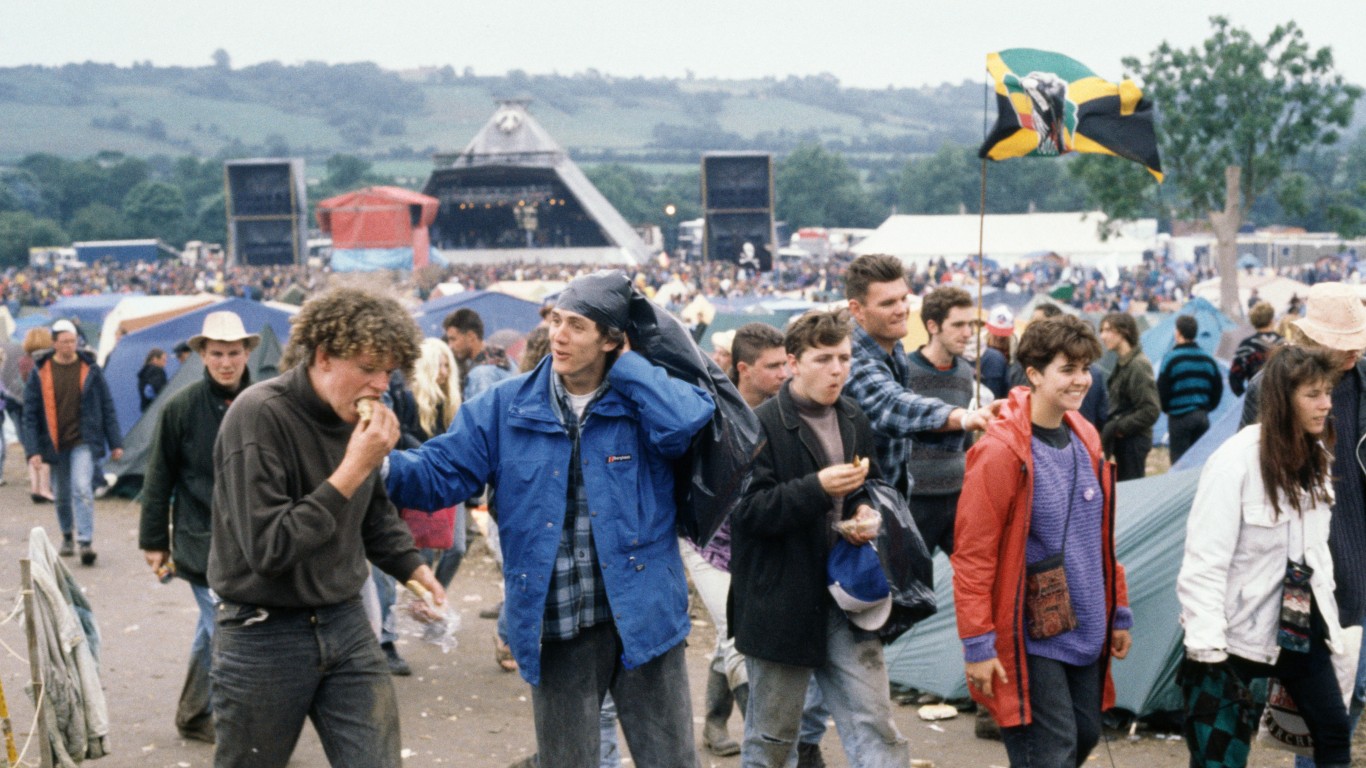
Glastonbury Festival
> Year: 1990
> Location: Pilton, Somerset, England
> Approximate attendance: 70K
This venerable British music festival, established in 1970 (performers in 1990 included The Cure and Sinéad O’Connor) ran into trouble not during the proceedings but immediately afterwards. In what became known as the Battle of Yeoman’s Bridge (a span on the festival grounds), when a group of New Age Travellers – the same “tribe” that had fought with police five years earlier at Stonehenge – attempted to scrounge leftovers from the site when audiences had mostly gone. Security guards accused them of stealing, and the two sides clashed violently. Molotov cocktails were thrown at cars, and riot police were called, making 235 arrests. Property damage was estimated at $350,000.
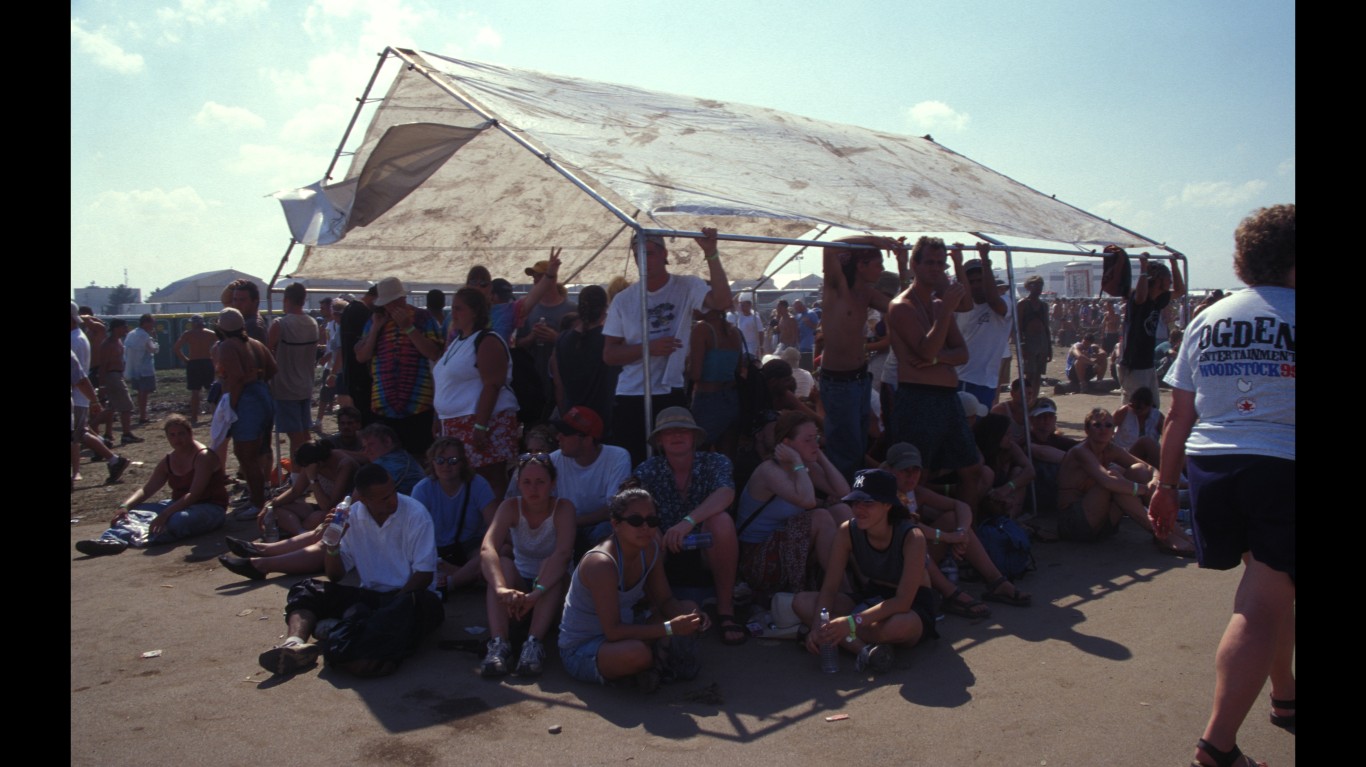
Woodstock ’99
> Year: 1999
> Location: Griffiss Air Force Base, Rome, New York
> Approximate attendance: 400K+
The second major attempt to capture the magic of the original 1969 Woodstock festival (after Woodstock ’94), with acts including the Red Hot Chili Peppers, Metallica, Limp Bizkit, and Kid Rock, angered attendees with overpriced food and drink, inadequate portable toilets, and amateur security measures, made worse by the 100º heat. Attendees turned hostile towards the performers, who sometimes egged them on, and a full-scale riot ensued. There were three fatalities (one from heat exhaustion), 40-plus arrests, between 4,000 and 5,000 fans treated for minor injuries onsite, another 253 treated at local hospitals, and extensive property damage throughout the venue.
[in-text-ad]
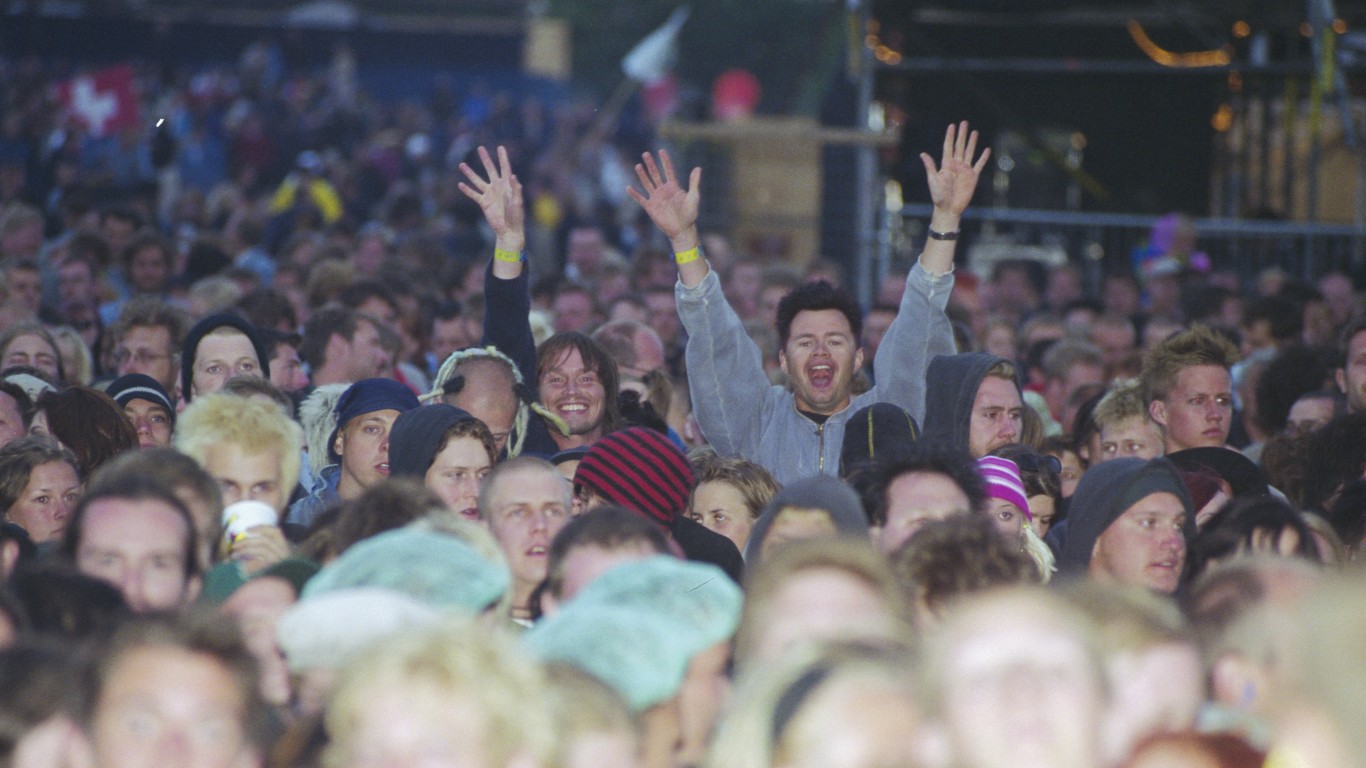
Roskilde Festival Disaster
> Year: 2000
> Location: Roskilde, Denmark
> Approximate attendance: 50K
Lou Reed, Oasis, Willie Nelson, Nine Inch Nails, and Pearl Jam were among the acts at this festival on an island west of Copenhagen. During Pearl Jam’s performance, people trying to crowd the stage fell, due partially to the slippery ground after a heavy rainfall, and others piled on top of them. Nine concert-goers died from asphyxiation, and another 26 were injured.

Glastonbury Festival
> Year: 2005
> Location: Pilton, Somerset, England
> Approximate attendance: 150K
Nature and not the audience was to blame for the disaster at this installment of the popular British festival – featuring White Stripes, Coldplay, The Killers, and Elvis Costello. Thunderstorms and constant heavy rainfall flooded several camping areas, a flash flood filled one site with four feet of water, and lightning struck tents, stages, and a bar. The festival continued, but the event wasn’t held the following year.
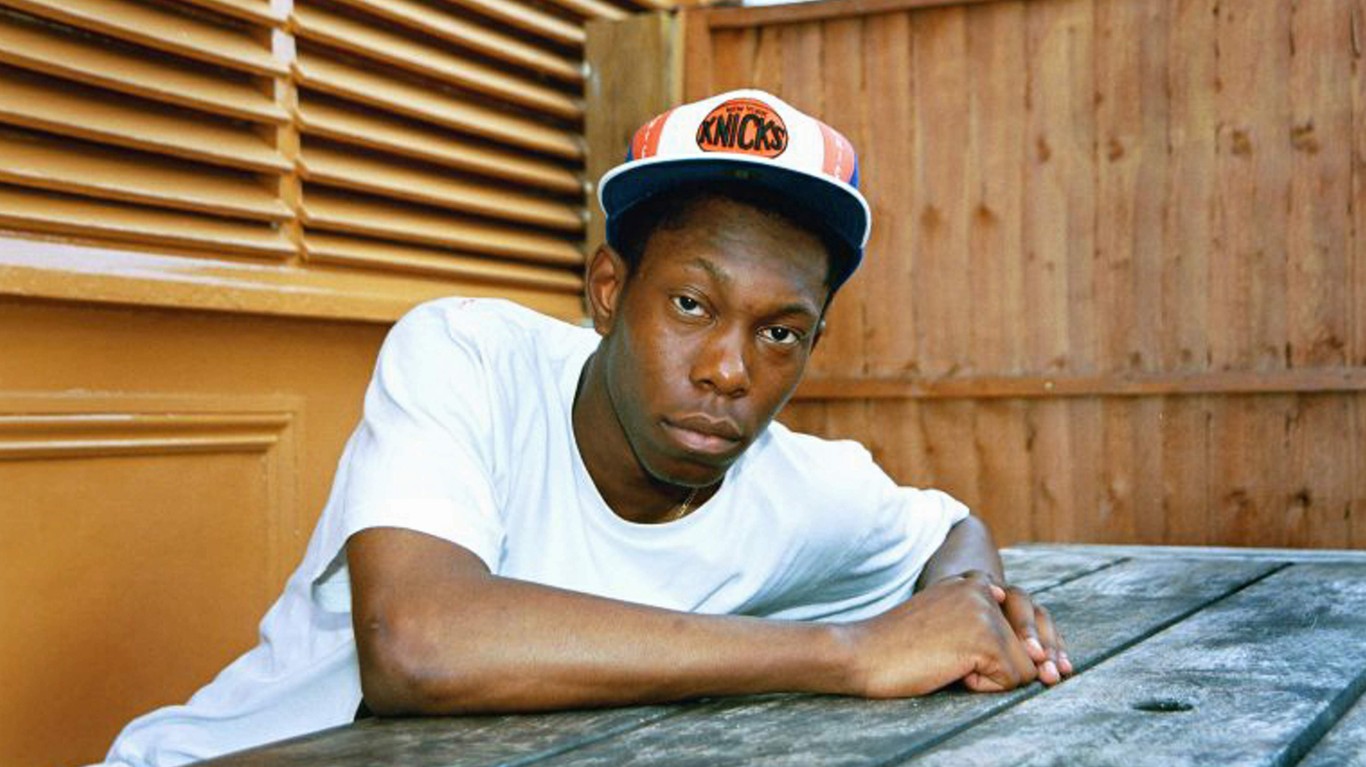
Zoo8
> Year: 2008
> Location: Port Lympne Wild Animal Park, Kent, England
> Approximate attendance: 30K+
This three-day event in an English safari park got off to a bad start when the gates were four hours late in opening on the first day. This unpromising beginning was followed by the collapse of perimeter fences, the closing down of one of the main stages due to an unsteady tent pole, and the last minute defection of several headliners, including British rapper Dizzee Rascal and indie rock band Athlete – who had learned that there was no money to pay them. The company that organized the festival went bankrupt, with debts of about $240,000.
[in-text-ad-2]
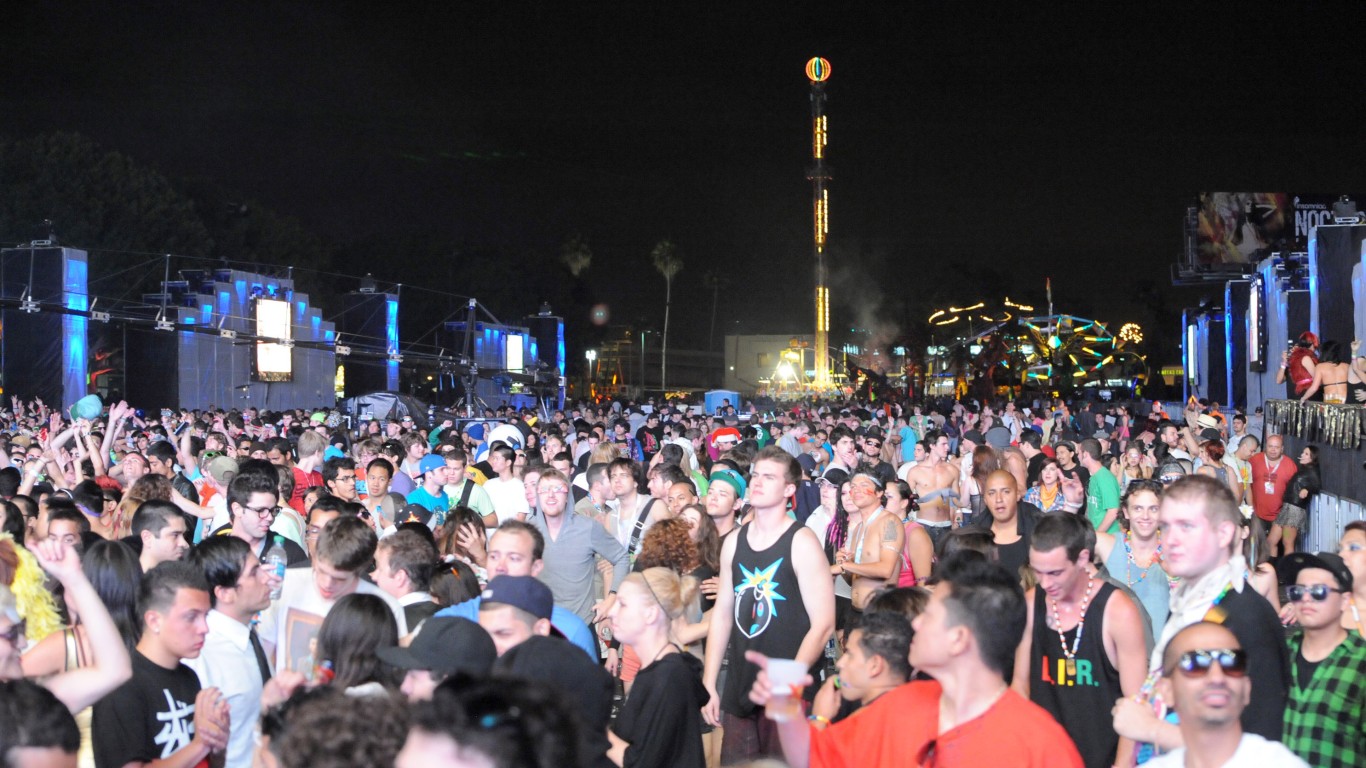
Electric Daisy Carnival Los Angeles
> Year: 2010
> Location: Los Angeles Memorial Coliseum, Los Angeles, California
> Approximate attendance: 185K
This massive electronic dance music event, founded in 1991, has taken place in various locations around California, as well as in Dallas, Las Vegas, and Orlando, with related events around the world. In the rave atmosphere in 2010, a 15-year-old girl collapsed and died after taking MDMA – better known as Ecstasy. (The official age for admission was 16, but it was widely disregarded.) In addition, police made 60 drug busts and 114 attendees were injured. The mother of the deceased girl filed a $5 million suit against both the county and the city of Los Angeles, on the grounds that they should have known there’d be widespread illicit drug use at the event. The case was settled for $190,000, according to news reports.
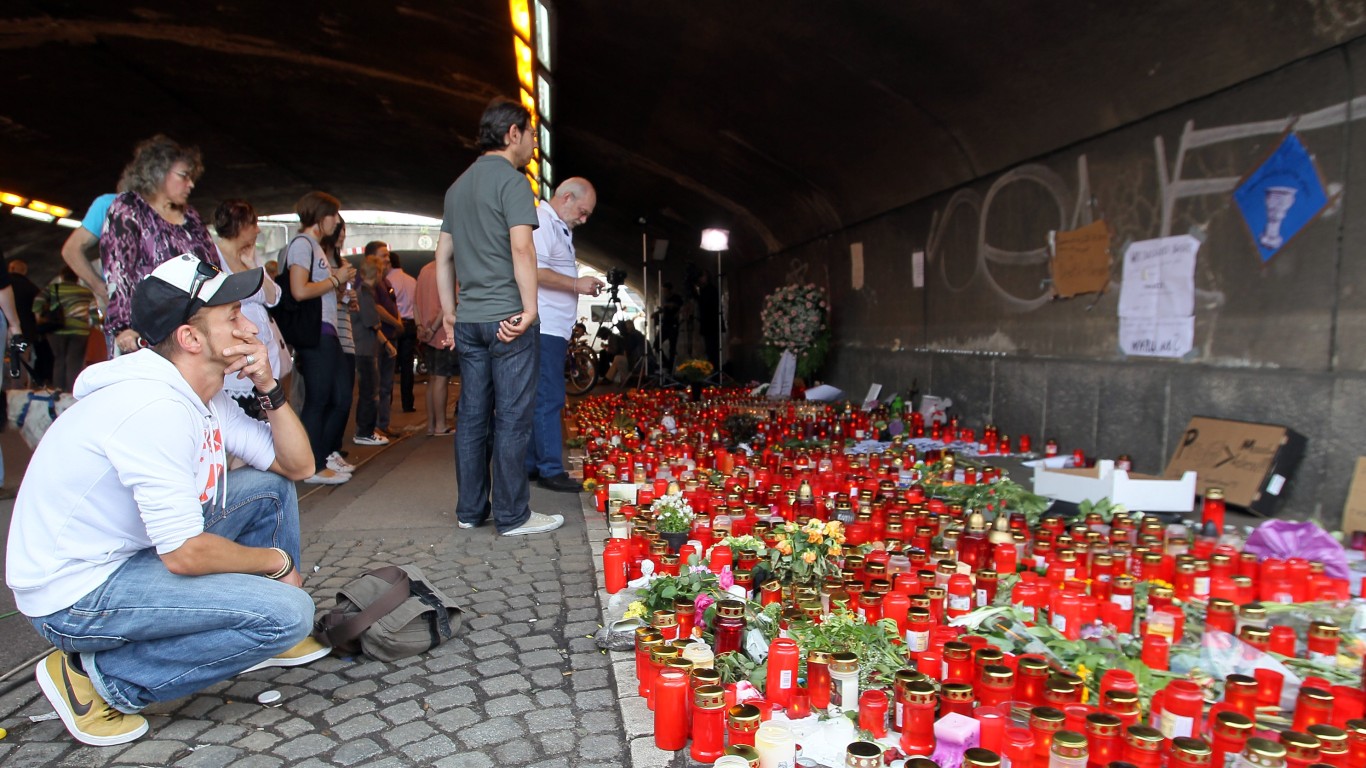
Love Parade
> Year: 2010
> Location: Duisburg, Germany
> Approximate attendance: 1.4M
Another electronic dance music festival, Love Parade was a free-access event (complete with actual parade), first held in Berlin in 1989. At the 2010 iteration, in the Ruhr region city of Duisburg, there was only one main entryway to the site, where a 250-yard tunnel from one direction met a cluster of underpasses from the other. As festival-goers flooded in, the police feared dangerous conditions from overcrowding and told people to turn back. As they tried to obey, others pushed forward, creating a condition called crowd turbulence – which restricts movement where the concentration of people is greatest. The crush claimed 21 lives, 15 on the scene, the rest in the hospital. In addition, about 650 people were injured.
[in-text-ad]
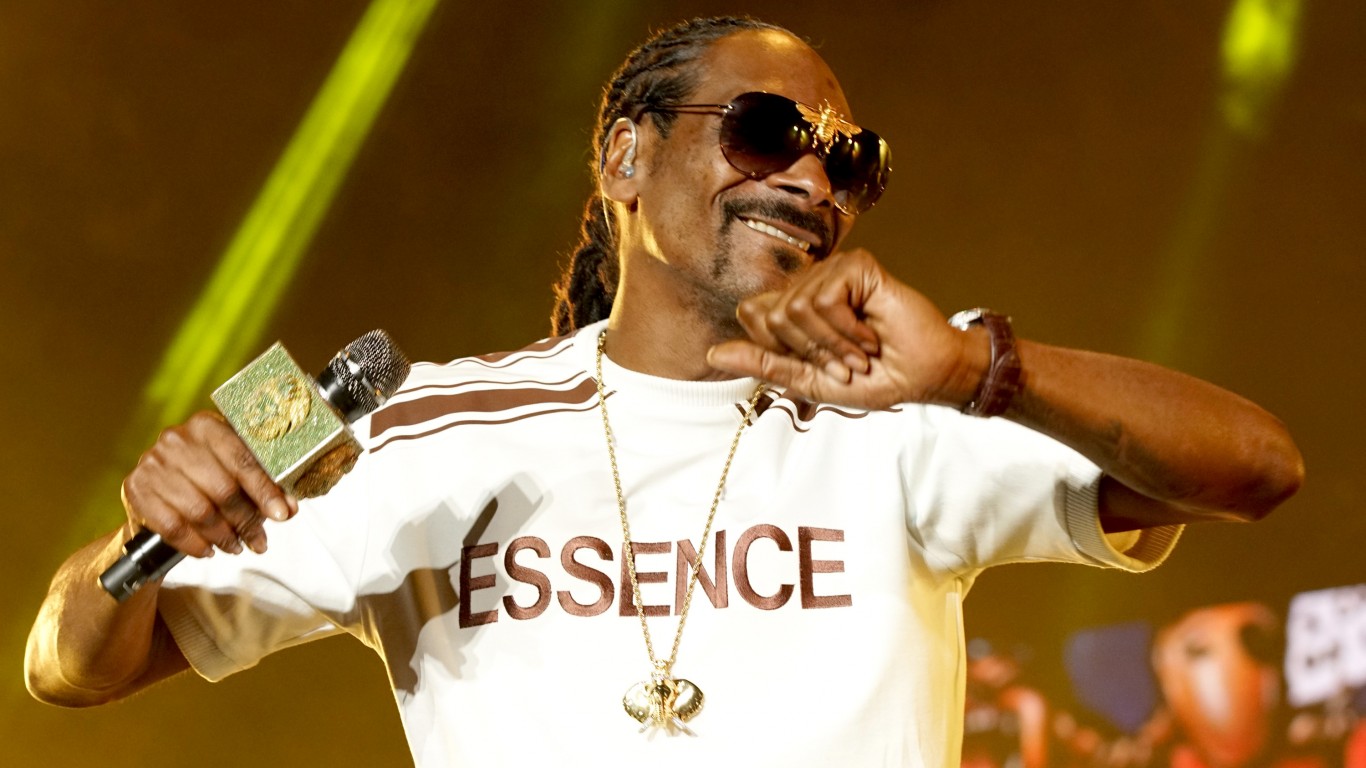
Bloc Festival
> Year: 2012
> Location: London Pleasure Gardens, Royal Victoria Docks, London, England
> Approximate attendance: 15K
Another electronic music event – though with rapper Snoop Dogg as the promised headliner – the Bloc Festival drew 15,000 people. However, the security staff felt that the number was unmanageable, and on the advice of the police, organizers announced cancellation of the proceedings due to safety concerns. The crowd was remarkably well-behaved as they were shepherded out by officials. A month later, the Pleasure Gardens, which had opened only in June, declared bankruptcy.
Sled Island Music and Arts Festival
> Year: 2013
> Location: Calgary, Alberta, Canada
> Approximate attendance: 40K
The Jesus and Mary Chain, Superchunk, and Explosions in the Sky were among the performers on the program at the seventh edition of this well-regarded four-day event. On the third morning of the festival, however, torrential rains, overflowing rivers, and excessive outflow from Glenmore Dam inundated Calgary, damaging much of the city and causing the evacuation of 26 communities. Organizers had no choice but to cancel the rest of the performances, and gave up $200,000 in refunds.
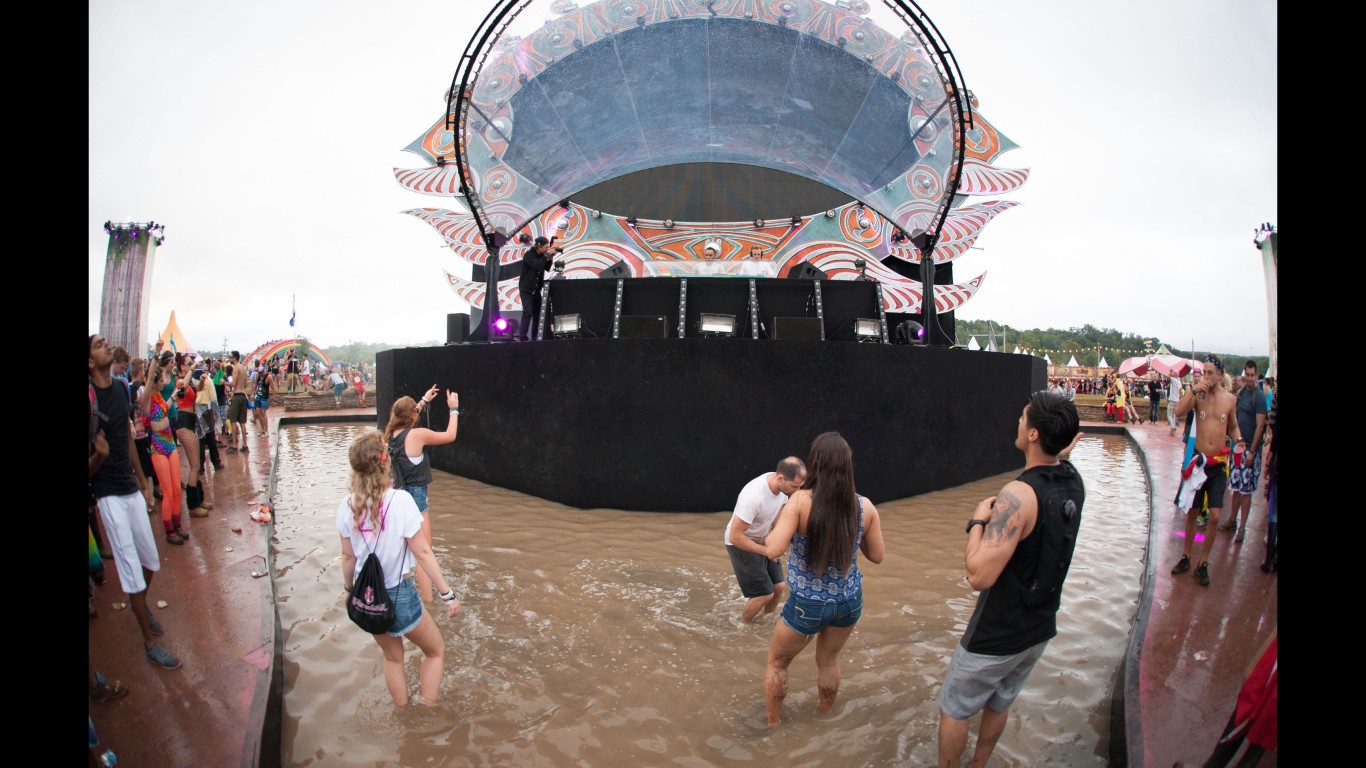
TomorrowWorld
> Year: 2015
> Location: Chattahoochee Hills, Georgia
> Approximate attendance: 150K
This two-day electronic music event was only held for three years. Its downfall came with the 2015 edition. Heavy rainfall on Friday turned the festival grounds into mush and access roads became impassable. Promised shuttle service returning attendees to Atlanta was curtailed and some people were forced to camp outdoors in the mud overnight or hike miles to a spot where they could get overpriced cabs or Ubers home. Saturday morning, organizers announced that only those still on the festival grounds could attend, offering refunds to others. Five months later, the group behind the festival filed for bankruptcy.
[in-text-ad-2]
Fyre Festival
> Year: 2017
> Location: Great Exuma, The Bahamas
> Approximate attendance: 5K+
Touted as an upscale festival with luxury accommodations, gourmet food, and a lineup including Pusha T, Blink-182, Migos, Lil Yachty, and many more, with tickets going for $500-$1,500, the Fyre Festival turned out to be a massive con job organized by scammer Billy McFarland, in collaboration with rapper Ja Rule (who was not implicated in the con). In reality, those arriving to the event found basic camp tents with rain-soaked mattresses, packaged sandwiches, almost non-existent security or medical facilities, no cellphone coverage, and insufficient portable toilets – with only a group of local musicians performing. Many attendees were stranded, while others had to charter planes to get off the island. McFarland is said to have defrauded investors in the event and related events of over $27 million. Convicted of two counts of wire fraud, he served less than four years in prison, but faces a $100 million lawsuit and other suits in numerous states. This April he announced that there would be a Fyre Festival II, but nothing further has been heard about it since then.
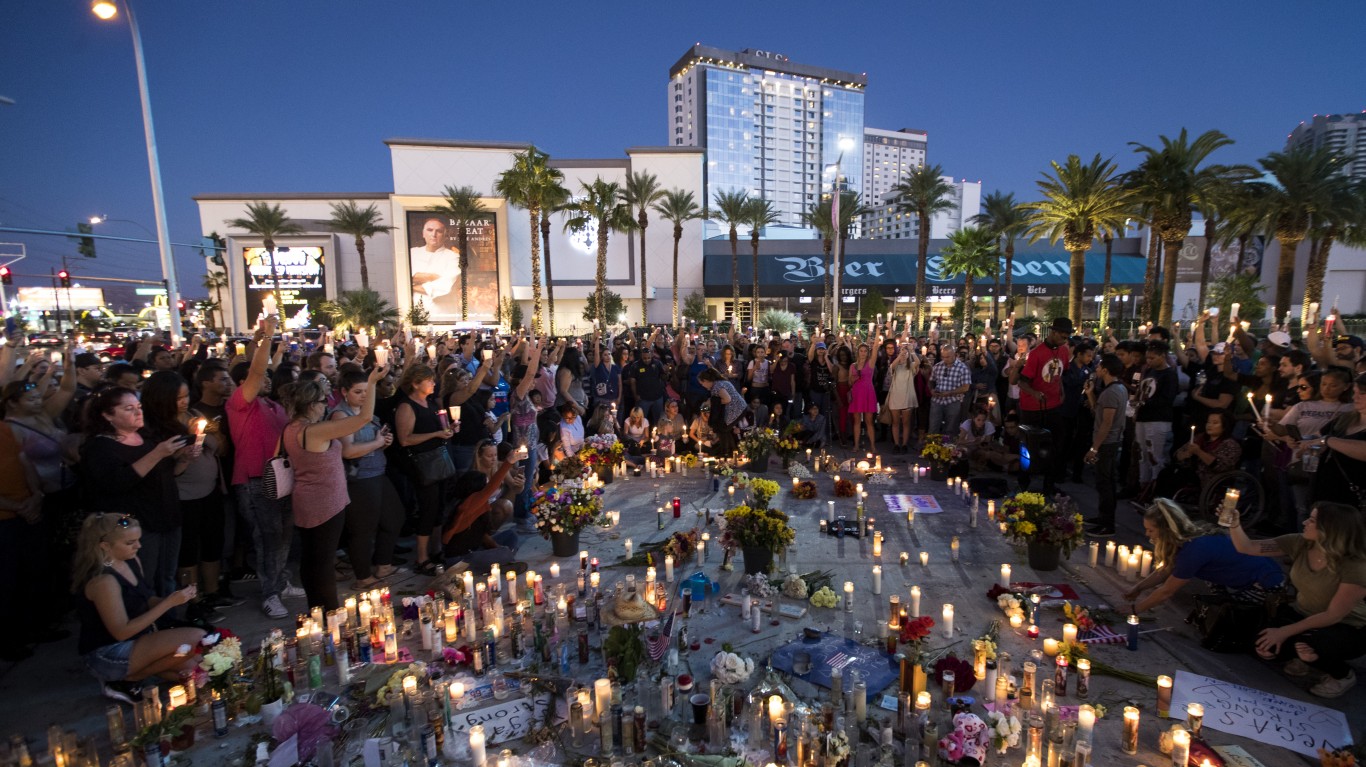
Route 91 Harvest
> Year: 2017
> Location: Paradise (Las Vegas Strip), Nevada
> Approximate attendance: 22K
The most tragic festival disaster ever involved this country music event, starring the likes of Eric Church, Jason Aldean, and Sam Hunt, held on a 15-acre lot on the famed Las Vegas Strip, which is a portion of Las Vegas Boulevard – formerly U.S. Route 91. On the third and last night of the festival, while Aldean was performing, a 64-year-old retired businessman named Stephen Paddock opened his 32nd floor window at the nearby Mandalay Bay Beach hotel and fired more than a thousand rounds into the crowd, mostly with AR-15-style rifles, killing 60 people and wounding more than 410. He then turned a handgun on himself. No motive for the attack was ever discovered, but it remains the single deadliest mass shooting by a lone gunman in U.S. history.
[in-text-ad]
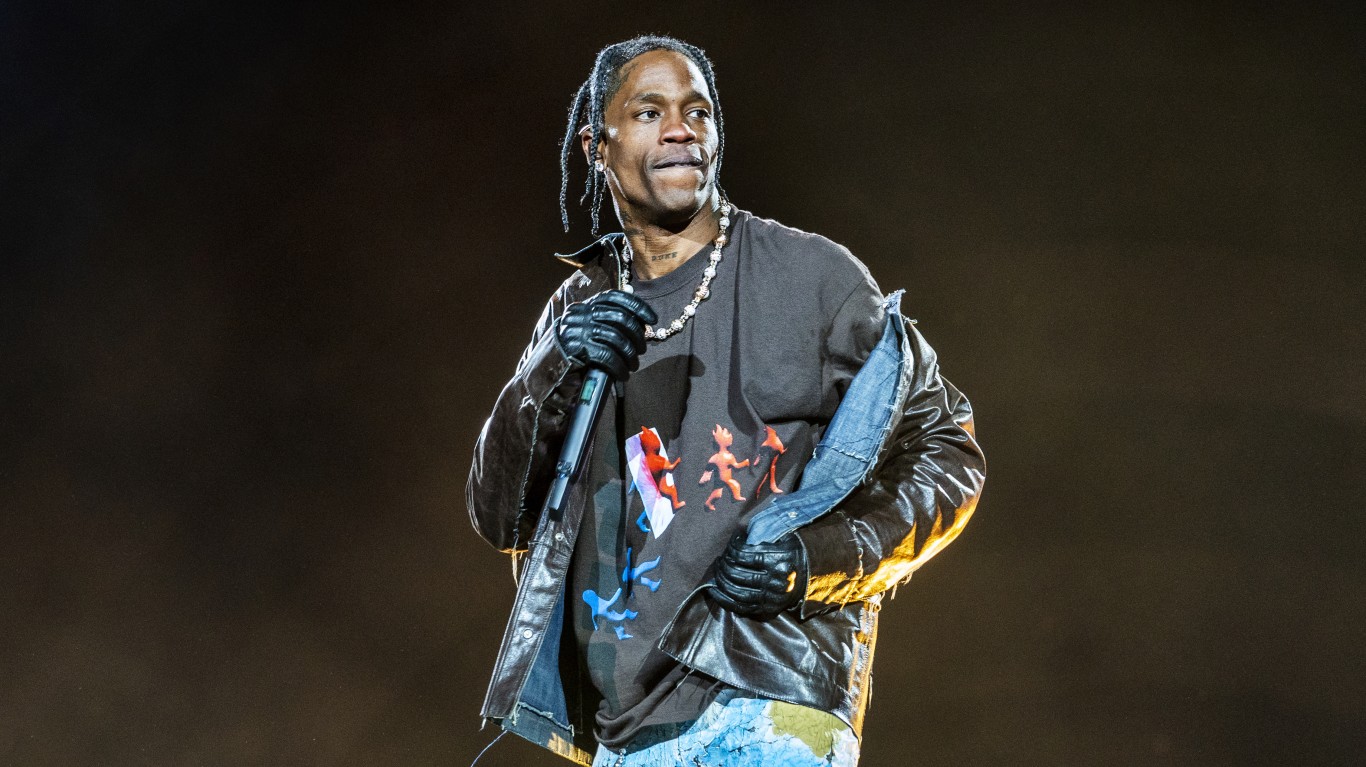
Astroworld
> Year: 2021
> Location: NRG Park, Houston, Texas
> Approximate attendance: 50K+
> Outcome: 10 fatalities; 25 hospitalized as a result of a crowd crush
The 2020 edition of this mostly-hip-hop festival founded by rapper Travis Scott was canceled due to the COVID pandemic. That may have had something to do with the enthusiasm with which fans bought tickets for the 2021 festival. A combination of factors, including inadequate crowd control measures, bad lighting and signage, narrow access aisles, and too few water stations, led to a crowd crush, ultimately resulting in 10 deaths from asphyxiation. There were also 25 hospitalizations and more than 300 people were treated onsite for medical issues.
Burning Man
> Year: 2023
> Location: Black Rock Desert, Pershing County, Nevada
> Approximate attendance: 73K
> Outcome: 1 fatality; many attendees stranded for several days after torrential rains
This celebrated establishment-counterculture festival not of music but of the arts and community has had controversies in the past, but nature turned this edition of it into a disaster. Halfway through the nine-day gathering, torrential rainfall blanketed the festival site, resulting in epic mud banks and stranding thousands of the attendees for several days as roads away from the event became impassable. There was one fatality, which authorities said was not weather-related but may have involved drug intoxication. Actor-comedian Chris Rock and DJ Diplo reportedly trudged through six miles of muck before hitching a ride.
Travel Cards Are Getting Too Good To Ignore (sponsored)
Credit card companies are pulling out all the stops, with the issuers are offering insane travel rewards and perks.
We’re talking huge sign-up bonuses, points on every purchase, and benefits like lounge access, travel credits, and free hotel nights. For travelers, these rewards can add up to thousands of dollars in flights, upgrades, and luxury experiences every year.
It’s like getting paid to travel — and it’s available to qualified borrowers who know where to look.
We’ve rounded up some of the best travel credit cards on the market. Click here to see the list. Don’t miss these offers — they won’t be this good forever.
Thank you for reading! Have some feedback for us?
Contact the 24/7 Wall St. editorial team.
